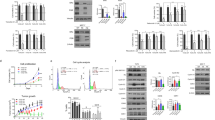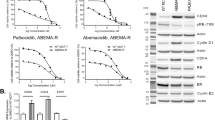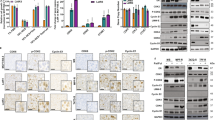Abstract
Antiestrogen resistance is a major problem in breast cancer treatment. Therefore, the search for new therapeutic targets and biomarkers for antiestrogen resistance is crucial. In this study, we performed a kinase inhibitor screen on antiestrogen responsive MCF-7 cells and a panel of MCF-7-derived tamoxifen- and fulvestrant-resistant cell lines. Our focus was to identify common and distinct molecular mechanisms involved in tamoxifen- and fulvestrant-resistant cell growth. We identified 18 inhibitors, of which the majority was common for both tamoxifen- and fulvestrant-resistant cell lines. Two compounds, WP1130 and JNJ-7706621, exhibiting prominent preferential growth inhibition of antiestrogen-resistant cell lines, were selected for further studies. WP1130, a deubiquitinase inhibitor, induced caspase-mediated cell death in both tamoxifen- and fulvestrant-resistant cell lines by destabilization of the anti-apoptotic protein Mcl-1. Mcl-1 expression was found upregulated in the antiestrogen-resistant cell lines and depletion of Mcl-1 in resistant cells caused decreased viability. JNJ-7706621, a dual Aurora kinase and cyclin-dependent kinase inhibitor, specifically inhibited growth and caused G2 phase cell cycle arrest of the tamoxifen-resistant cell lines. Knockdown studies showed that Aurora kinase A is essential for growth of the tamoxifen-resistant cells and inhibition of Aurora kinase A resensitized tamoxifen-resistant cells to tamoxifen treatment. Preferential growth inhibition by WP1130 and JNJ-7706621 was also found in T47D-derived tamoxifen-resistant cell lines, pointing at Mcl-1 and Aurora kinase A as potential treatment targets. In addition, tumor samples from 244 estrogen receptor-positive breast cancer patients treated with adjuvant tamoxifen showed that higher expression level of Aurora kinase A was significantly associated with shorter disease-free and overall survival, demonstrating the potential of Aurora kinase A as a biomarker for tamoxifen resistance.
This is a preview of subscription content, access via your institution
Access options
Subscribe to this journal
Receive 50 print issues and online access
$259.00 per year
only $5.18 per issue
Buy this article
- Purchase on Springer Link
- Instant access to full article PDF
Prices may be subject to local taxes which are calculated during checkout








Similar content being viewed by others
References
Davies C, Godwin J, Gray R, Clarke M, Cutter D, Darby S et al. Relevance of breast cancer hormone receptors and other factors to the efficacy of adjuvant tamoxifen: patient-level meta-analysis of randomised trials. Lancet 2011; 378: 771–784.
Howell A, Osborne CK, Morris C, Wakeling AE . ICI 182 780 (Faslodex): development of a novel, ‘pure’ antiestrogen. Cancer 2000; 89: 817–825.
Palmieri C, Patten DK, Januszewski A, Zucchini G, Howell SJ . Breast cancer: current and future endocrine therapies. Mol Cell Endocrinol 2013; 382: 695–723.
Musgrove EA, Sutherland RL . Biological determinants of endocrine resistance in breast cancer. Nat Rev Cancer 2009; 9: 631–643.
Nahta R, O'Regan RM . Therapeutic implications of estrogen receptor signaling in HER2-positive breast cancers. Breast Cancer Res Treat 2012; 135: 39–48.
Rasmussen BB, Regan MM, Lykkesfeldt AE, Dell'Orto P, Del Curto B, Henriksen KL et al. Adjuvant letrozole versus tamoxifen according to centrally-assessed ERBB2 status for postmenopausal women with endocrine-responsive early breast cancer: supplementary results from the BIG 1-98 randomised trial. Lancet Oncol 2008; 9: 23–28.
Drury SC, Detre S, Leary A, Salter J, Reis-Filho J, Barbashina V et al. Changes in breast cancer biomarkers in the IGF1R/PI3K pathway in recurrent breast cancer after tamoxifen treatment. Endocr Relat Cancer 2011; 18: 565–577.
Frogne T, Laenkholm AV, Lyng MB, Henriksen KL, Lykkesfeldt AE . Determination of HER2 phosphorylation at tyrosine 1221/1222 improves prediction of poor survival for breast cancer patients with hormone receptor-positive tumors. Breast Cancer Res 2009; 11: R11.
Frogne T, Benjaminsen RV, Sonne-Hansen K, Sorensen BS, Nexo E, Laenkholm AV et al. Activation of ErbB3, EGFR and Erk is essential for growth of human breast cancer cell lines with acquired resistance to fulvestrant. Breast Cancer Res Treat 2009; 114: 263–275.
Sonne-Hansen K, Norrie IC, Emdal KB, Benjaminsen RV, Frogne T, Christiansen IJ et al. Breast cancer cells can switch between estrogen receptor alpha and ErbB signaling and combined treatment against both signaling pathways postpones development of resistance. Breast Cancer Res Treat 2010; 121: 601–613.
Thrane S, Lykkesfeldt AE, Larsen MS, Sorensen BS, Yde CW . Estrogen receptor alpha is the major driving factor for growth in tamoxifen-resistant breast cancer and supported by HER/ERK signaling. Breast Cancer Res Treat 2013; 139: 71–80.
Yde CW, Emdal KB, Guerra B, Lykkesfeldt AE . NFkappaB signaling is important for growth of antiestrogen resistant breast cancer cells. Breast Cancer Res Treat 2012; 135: 67–78.
Hurtado A, Holmes KA, Ross-Innes CS, Schmidt D, Carroll JS . FOXA1 is a key determinant of estrogen receptor function and endocrine response. Nat Genet 2011; 43: 27–33.
Ross-Innes CS, Stark R, Teschendorff AE, Holmes KA, Ali HR, Dunning MJ et al. Differential oestrogen receptor binding is associated with clinical outcome in breast cancer. Nature 2012; 481: 389–393.
Howell A, Robertson J . Response to a specific antioestrogen (ICI 182780) in tamoxifen-resistant breast cancer. Lancet 1995; 345: 989–990.
Robertson JF, Osborne CK, Howell A, Jones SE, Mauriac L, Ellis M et al. Fulvestrant versus anastrozole for the treatment of advanced breast carcinoma in postmenopausal women: a prospective combined analysis of two multicenter trials. Cancer 2003; 98: 229–238.
Frankel LB, Lykkesfeldt AE, Hansen JB, Stenvang J . Protein Kinase C alpha is a marker for antiestrogen resistance and is involved in the growth of tamoxifen resistant human breast cancer cells. Breast Cancer Res Treat 2007; 104: 165–179.
Frogne T, Jepsen JS, Larsen SS, Fog CK, Brockdorff BL, Lykkesfeldt AE . Antiestrogen-resistant human breast cancer cells require activated protein kinase B/Akt for growth. Endocr Relat Cancer 2005; 12: 599–614.
Leary AF, Drury S, Detre S, Pancholi S, Lykkesfeldt AE, Martin LA et al. Lapatinib restores hormone sensitivity with differential effects on estrogen receptor signaling in cell models of human epidermal growth factor receptor 2-negative breast cancer with acquired endocrine resistance. Clin Cancer Res 2010; 16: 1486–1497.
Bartholomeusz GA, Talpaz M, Kapuria V, Kong LY, Wang S, Estrov Z et al. Activation of a novel Bcr/Abl destruction pathway by WP1130 induces apoptosis of chronic myelogenous leukemia cells. Blood 2007; 109: 3470–3478.
Sun H, Kapuria V, Peterson LF, Fang D, Bornmann WG, Bartholomeusz G et al. Bcr-Abl ubiquitination and Usp9x inhibition block kinase signaling and promote CML cell apoptosis. Blood 2011; 117: 3151–3162.
Christensen GL, Jepsen JS, Fog CK, Christensen IJ, Lykkesfeldt AE . Sequential versus combined treatment of human breast cancer cells with antiestrogens and the vitamin D analogue EB1089 and evaluation of predictive markers for vitamin D treatment. Breast Cancer Res Treat 2004; 85: 53–63.
Larsen SS, Heiberg I, Lykkesfeldt AE . Anti-oestrogen resistant human breast cancer cell lines are more sensitive towards treatment with the vitamin D analogue EB1089 than parent MCF-7 cells. Br J Cancer 2001; 84: 686–690.
Lykkesfeldt AE, Larsen SS, Briand P . Human breast cancer cell lines resistant to pure anti-estrogens are sensitive to tamoxifen treatment. Int J Cancer 1995; 61: 529–534.
Yde CW, Gyrd-Hansen M, Lykkesfeldt AE, Issinger OG, Stenvang J . Breast cancer cells with acquired antiestrogen resistance are sensitized to cisplatin-induced cell death. Mol Cancer Ther 2007; 6: 1869–1876.
Cohen NA, Stewart ML, Gavathiotis E, Tepper JL, Bruekner SR, Koss B et al. A competitive stapled peptide screen identifies a selective small molecule that overcomes MCL-1-dependent leukemia cell survival. Chemistry & biology 2012; 19: 1175–1186.
Emanuel S, Rugg CA, Gruninger RH, Lin R, Fuentes-Pesquera A, Connolly PJ et al. The in vitro and in vivo effects of JNJ-7706621: a dual inhibitor of cyclin-dependent kinases and aurora kinases. Cancer Res 2005; 65: 9038–9046.
Altieri DC . Validating survivin as a cancer therapeutic target. Nat Rev Cancer 2003; 3: 46–54.
Hendzel MJ, Wei Y, Mancini MA, Van Hooser A, Ranalli T, Brinkley BR et al. Mitosis-specific phosphorylation of histone H3 initiates primarily within pericentromeric heterochromatin during G2 and spreads in an ordered fashion coincident with mitotic chromosome condensation. Chromosoma 1997; 106: 348–360.
Dar AA, Goff LW, Majid S, Berlin J, El-Rifai W . Aurora kinase inhibitors—rising stars in cancer therapeutics?. Mol Cancer Ther 2010; 9: 268–278.
Lykkesfeldt AE, Madsen MW, Briand P . Altered expression of estrogen-regulated genes in a tamoxifen-resistant and ICI 164 384 and ICI 182 780 sensitive human breast cancer cell line, MCF-7/TAMR-1. Cancer Res 1994; 54: 1587–1595.
Chan SK, Hill ME, Gullick WJ . The role of the epidermal growth factor receptor in breast cancer. J Mammary Gland Biol Neoplasia 2006; 11: 3–11.
Hutcheson IR, Knowlden JM, Madden TA, Barrow D, Gee JM, Wakeling AE et al. Oestrogen receptor-mediated modulation of the EGFR/MAPK pathway in tamoxifen-resistant MCF-7 cells. Breast Cancer Res Treat 2003; 81: 81–93.
Kapuria V, Peterson LF, Fang D, Bornmann WG, Talpaz M, Donato NJ . Deubiquitinase inhibition by small-molecule WP1130 triggers aggresome formation and tumor cell apoptosis. Cancer Res 2010; 70: 9265–9276.
Teixeira C, Reed JC, Pratt MA . Estrogen promotes chemotherapeutic drug resistance by a mechanism involving Bcl-2 proto-oncogene expression in human breast cancer cells. Cancer Res 1995; 55: 3902–3907.
Thomas LW, Lam C, Edwards SW . Mcl-1; the molecular regulation of protein function. FEBS Lett 2010; 584: 2981–2989.
Wang JM, Chao JR, Chen W, Kuo ML, Yen JJ, Yang-Yen HF . The antiapoptotic gene mcl-1 is up-regulated by the phosphatidylinositol 3-kinase/Akt signaling pathway through a transcription factor complex containing CREB. Mol Cell Biol 1999; 19: 6195–6206.
Booy EP, Henson ES, Gibson SB . Epidermal growth factor regulates Mcl-1 expression through the MAPK-Elk-1 signalling pathway contributing to cell survival in breast cancer. Oncogene 2011; 30: 2367–2378.
Henson ES, Hu X, Gibson SB . Herceptin sensitizes ErbB2-overexpressing cells to apoptosis by reducing antiapoptotic Mcl-1 expression. Clin Cancer Res 2006; 12: 845–853.
Ding Q, He X, Xia W, Hsu JM, Chen CT, Li LY et al. Myeloid cell leukemia-1 inversely correlates with glycogen synthase kinase-3beta activity and associates with poor prognosis in human breast cancer. Cancer Res 2007; 67: 4564–4571.
Vogler M, Dinsdale D, Dyer MJ, Cohen GM . Bcl-2 inhibitors: small molecules with a big impact on cancer therapy. Cell Death Differ 2009; 16: 360–367.
Kallio MJ, McCleland ML, Stukenberg PT, Gorbsky GJ . Inhibition of aurora B kinase blocks chromosome segregation, overrides the spindle checkpoint, and perturbs microtubule dynamics in mitosis. Curr Biol 2002; 12: 900–905.
Hirota T, Kunitoku N, Sasayama T, Marumoto T, Zhang D, Nitta M et al. Aurora-A and an interacting activator, the LIM protein Ajuba, are required for mitotic commitment in human cells. Cell 2003; 114: 585–598.
Crosio C, Fimia GM, Loury R, Kimura M, Okano Y, Zhou H et al. Mitotic phosphorylation of histone H3: spatio-temporal regulation by mammalian Aurora kinases. Mol Cell Biol 2002; 22: 874–885.
Goldenson B, Crispino JD . The aurora kinases in cell cycle and leukemia. Oncogene (e-pub ahead of print 17 March 2014; doi:10.1038/onc.2014.14).
Pancholi S, Lykkesfeldt AE, Hilmi C, Banerjee S, Leary A, Drury S et al. ERBB2 influences the subcellular localization of the estrogen receptor in tamoxifen-resistant MCF-7 cells leading to the activation of AKT and RPS6KA2. Endocr Relat Cancer 2008; 15: 985–1002.
Le Gouill S, Podar K, Harousseau JL, Anderson KC . Mcl-1 regulation and its role in multiple myeloma. Cell cycle 2004; 3: 1259–1262.
Ali HR, Dawson SJ, Blows FM, Provenzano E, Pharoah PD, Caldas C . Aurora kinase A outperforms Ki67 as a prognostic marker in ER-positive breast cancer. Br J Cancer 2012; 106: 1798–1806.
Zheng XQ, Guo JP, Yang H, Kanai M, He LL, Li YY et al. Aurora-A is a determinant of tamoxifen sensitivity through phosphorylation of ERα in breast cancer. Oncogene 2014; 33: 4985–4996.
Siggelkow W, Boehm D, Gebhard S, Battista M, Sicking I, Lebrecht A et al. Expression of aurora kinase A is associated with metastasis-free survival in node-negative breast cancer patients. BMC Cancer 2012; 12: 562.
Briand P, Lykkesfeldt AE . Effect of estrogen and antiestrogen on the human breast cancer cell line MCF-7 adapted to growth at low serum concentration. Cancer Res 1984; 44: 1114–1119.
Lundholt BK, Briand P, Lykkesfeldt AE . Growth inhibition and growth stimulation by estradiol of estrogen receptor transfected human breast epithelial cell lines involve different pathways. Breast Cancer Res Treat 2001; 67: 199–214.
Zhang H, Guttikonda S, Roberts L, Uziel T, Semizarov D, Elmore SW et al. Mcl-1 is critical for survival in a subgroup of non-small-cell lung cancer cell lines. Oncogene 2011; 30: 1963–1968.
Yde CW, Olsen BB, Meek D, Watanabe N, Guerra B . The regulatory beta-subunit of protein kinase CK2 regulates cell-cycle progression at the onset of mitosis. Oncogene 2008; 27: 4986–4997.
Moller S, Jensen MB, Ejlertsen B, Bjerre KD, Larsen M, Hansen HB et al. The clinical database and the treatment guidelines of the Danish Breast Cancer Cooperative Group (DBCG); its 30-years experience and future promise. Acta Oncol 2008; 47: 506–524.
Henriksen KL, Rasmussen BB, Lykkesfeldt AE, Moller S, Ejlertsen B, Mouridsen HT . Semi-quantitative scoring of potentially predictive markers for endocrine treatment of breast cancer: a comparison between whole sections and tissue microarrays. J Clin Pathol 2007; 60: 397–404.
Henriksen KL, Rasmussen BB, Lykkesfeldt AE, Moller S, Ejlertsen B, Mouridsen HT et al. activity profile including ER, PR, Bcl-2 and IGF-IR may have potential as selection criterion for letrozole or tamoxifen treatment of patients with advanced breast cancer. Acta Oncol 2009; 48: 522–531.
Acknowledgements
We thank Jane Lind Christensen and Birgit Reiter for excellent technical assistance and Klaus Kaae Andersen and Ann-Sophie Søgaard for help with statistical analysis. This study was supported by A Race Against Breast Cancer, Astrid Thaysen’s grant (ATL12/01), A.P. Møller Foundation for the Advancement of Medical Science (12–374), Danish Cancer Research Foundation, Danish Cancer Society, Danske Bank Foundation, Hede Nielsen Family Foundation, Leo Nielsen’s grant (LN12/07), Novo Nordisk Foundation and Sigvald and Edith Rasmussen’s grant.
Author information
Authors and Affiliations
Corresponding author
Ethics declarations
Competing interests
The authors declare no conflict of interest.
Additional information
Supplementary Information accompanies this paper on the Oncogene website
Rights and permissions
About this article
Cite this article
Thrane, S., Pedersen, A., Thomsen, M. et al. A kinase inhibitor screen identifies Mcl-1 and Aurora kinase A as novel treatment targets in antiestrogen-resistant breast cancer cells. Oncogene 34, 4199–4210 (2015). https://doi.org/10.1038/onc.2014.351
Received:
Revised:
Accepted:
Published:
Issue Date:
DOI: https://doi.org/10.1038/onc.2014.351
This article is cited by
-
Emerging systemic therapy options beyond CDK4/6 inhibitors for hormone receptor-positive HER2-negative advanced breast cancer
npj Breast Cancer (2023)
-
Differential reprogramming of breast cancer subtypes in 3D cultures and implications for sensitivity to targeted therapy
Scientific Reports (2021)
-
Molecular markers associated with the outcome of tamoxifen treatment in estrogen receptor-positive breast cancer patients: scoping review and in silico analysis
Discover Oncology (2021)
-
MCM3 upregulation confers endocrine resistance in breast cancer and is a predictive marker of diminished tamoxifen benefit
npj Breast Cancer (2021)
-
Increased Expression of Gankyrin and Stemness Factor Oct-4 are Associated with Unfavorable Clinical Outcomes and Poor Benefit of Tamoxifen in Breast Carcinoma Patients
Pathology & Oncology Research (2020)



